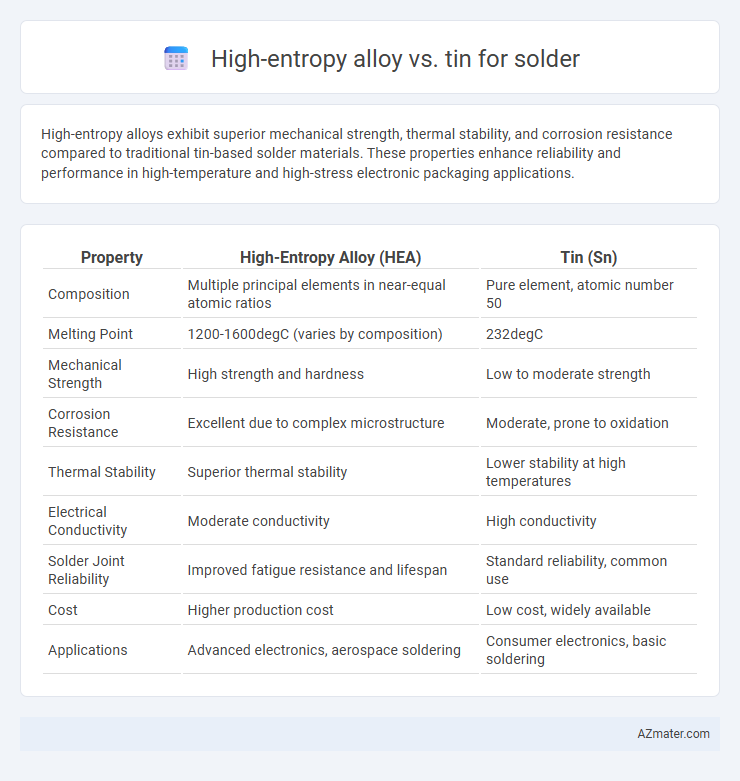High-entropy alloys exhibit superior mechanical strength, thermal stability, and corrosion resistance compared to traditional tin-based solder materials. These properties enhance reliability and performance in high-temperature and high-stress electronic packaging applications.
Table of Comparison
| Property | High-Entropy Alloy (HEA) | Tin (Sn) |
|---|---|---|
| Composition | Multiple principal elements in near-equal atomic ratios | Pure element, atomic number 50 |
| Melting Point | 1200-1600degC (varies by composition) | 232degC |
| Mechanical Strength | High strength and hardness | Low to moderate strength |
| Corrosion Resistance | Excellent due to complex microstructure | Moderate, prone to oxidation |
| Thermal Stability | Superior thermal stability | Lower stability at high temperatures |
| Electrical Conductivity | Moderate conductivity | High conductivity |
| Solder Joint Reliability | Improved fatigue resistance and lifespan | Standard reliability, common use |
| Cost | Higher production cost | Low cost, widely available |
| Applications | Advanced electronics, aerospace soldering | Consumer electronics, basic soldering |
Introduction to High-Entropy Alloys and Tin in Soldering
High-entropy alloys (HEAs) consist of multiple principal elements that create unique microstructures, offering superior mechanical strength and corrosion resistance compared to traditional solder materials. Tin (Sn) has long been the primary metal in conventional solders, valued for its low melting point and excellent wettability but limited by issues like brittleness and susceptibility to thermal fatigue. Innovations in HEA-based solders aim to overcome these limitations by enhancing joint reliability and performance in electronics assembly through tailored compositions.
Composition and Structure: High-Entropy Alloys vs Tin
High-entropy alloys (HEAs) consist of five or more principal elements in near-equal atomic percentages, creating a complex, multi-element matrix that enhances mechanical strength and thermal stability. In contrast, tin used in solder is typically a single-element or binary alloy, often combined with small amounts of silver, copper, or lead to improve performance but lacks the compositional complexity of HEAs. The high configurational entropy of HEAs stabilizes simple solid-solution phases (FCC, BCC) rather than intermetallic compounds common in tin-based solders, resulting in superior microstructural stability during thermal cycling.
Mechanical Properties Comparison
High-entropy alloys (HEAs) exhibit superior mechanical properties compared to traditional tin-based solders, including higher tensile strength, enhanced hardness, and improved wear resistance. HEAs maintain structural stability and mechanical integrity at elevated temperatures where tin solders tend to soften and degrade. This makes HEAs particularly advantageous for applications requiring robust mechanical performance and thermal stability in electronic soldering.
Thermal Stability and Melting Points
High-entropy alloys (HEAs) exhibit superior thermal stability compared to tin-based solders, maintaining structural integrity at elevated temperatures beyond 800degC, whereas pure tin melts at approximately 232degC. The elevated melting points of HEAs, often exceeding 1000degC depending on composition, ensure reliable performance in high-temperature electronic applications where tin solders would liquefy and potentially cause joint failure. This enhanced thermal resilience positions high-entropy alloys as promising candidates for advanced solder materials requiring extended service life under thermal stress.
Electrical Conductivity in Solder Applications
High-entropy alloys (HEAs) exhibit superior electrical conductivity compared to traditional tin-based solders due to their multi-principal element composition, which reduces electron scattering. This enhanced conductivity improves signal integrity and reduces resistance in solder joints, critical for high-frequency and high-performance electronic applications. The tunable properties of HEAs allow for optimization of electrical performance while maintaining mechanical robustness, making them a promising alternative to conventional tin solders.
Corrosion and Oxidation Resistance
High-entropy alloys (HEAs) exhibit superior corrosion and oxidation resistance compared to traditional tin-based solders due to their multi-elemental composition, which forms stable, protective oxide layers. The complex microstructure of HEAs reduces elemental diffusion rates, enhancing durability in harsh environments where tin solders tend to oxidize and degrade rapidly. This improved resistance extends the lifespan and reliability of electronic joints in high-temperature and corrosive conditions.
Environmental and Toxicological Considerations
High-entropy alloys (HEAs) for solder applications present a sustainable alternative to traditional tin-based solders due to their reduced reliance on toxic elements like lead and antimony, which are commonly associated with environmental contamination and human health risks. HEAs, composed of multiple principal elements in near-equal proportions, enhance corrosion resistance and thermal stability, potentially reducing the frequency of solder joint failures and electronic waste generation. Tin solders, despite widespread use, raise concerns over bioaccumulation and toxicity in aquatic ecosystems, driving research toward environmentally benign HEAs that minimize hazardous material use while maintaining solder performance.
Cost and Availability Factors
High-entropy alloys for solder applications typically incur higher costs due to their complex multi-element compositions and limited large-scale production, whereas tin is widely available and cost-effective as a primary solder material. The abundance of tin in global markets ensures stable supply chains, contrasting with the less mature manufacturing and sourcing processes of high-entropy alloys. Cost efficiency and ready availability remain significant advantages of tin compared to the emerging, yet more expensive and less accessible high-entropy solder alternatives.
Application Suitability in Modern Electronics
High-entropy alloys (HEAs) exhibit superior thermal stability, mechanical strength, and corrosion resistance compared to traditional tin-based solders, making them highly suitable for high-performance and high-reliability electronic applications. HEAs maintain structural integrity under extreme thermal cycling and mechanical stress, critical for modern electronics in aerospace, automotive, and advanced computing devices. Tin-based solders, while cost-effective and easy to process, often struggle with fatigue and electromigration, limiting their effectiveness in cutting-edge electronic assemblies requiring enhanced durability and longevity.
Future Trends in Solder Materials: High-Entropy Alloys vs Tin
High-entropy alloys (HEAs) are emerging as a promising alternative to traditional tin-based solders due to their superior mechanical strength, thermal stability, and resistance to electromigration, essential for the reliability of next-generation electronic devices. Research highlights that HEA solder materials can operate efficiently at higher temperatures and offer improved joint longevity compared to conventional tin-lead and lead-free tin solders. As the electronics industry pushes towards miniaturization and higher performance, the adoption of HEA solders is expected to rise, driven by their tunable composition and enhanced durability under extreme operating conditions.

Infographic: High-entropy alloy vs Tin for Solder
 azmater.com
azmater.com